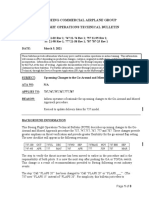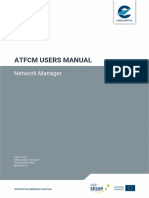NITS Briefing
Uploaded by
ZawNITS Briefing
Uploaded by
ZawNITS briefing
The NITS briefing is a simple mnemonic to guide the person using it through a briefing format whilst
in a high stress situation. It has to be simple and unemotional. Too much information or
complicated jargon will stop the importance of the message and take too much time.
It normally starts with the captain briefing the passengers or the cabin crew if there is one.
N ature: What is the nature of the emergency?
For example, “The left engine is on fire and has been shut down”
I ntention: What is the intention of the captain? This will tell the rest of the crew what checklist of
their own they may need to follow. For example,
“We are going to make an Emergency landing at MDL airport”
T ime: How much time is available to prepare for the emergency landing? For example,
“We will be landed in 12 minute, so have everything prepared in 10 minutes”
S pecial Instructions: Is there anything else the person receiving the brief needs to know about the
situation that will help them and possibly save lives?
For example, “The left engine is still on fire so evacuate the aircraft through the right
exit only. Emergency services are waiting for us”
To ensure that the NITS briefing has been fully understood, then the person receiving the brief
should repeat the brief back.
For example “OK Captain, * Left engine is on fire and has been shutdown and we are going
to make an ** Emergency landing at MDL. *** Aircraft to be ready in 10 minutes for an
evacuation through the right-hand exit only and Emergency services are waiting." If
the captain heard everything read back correctly, then he can ask the person to carry on with their
preparation. If not, he does the NITS again.
Once the captain has briefed one crew member or passenger, then the information can be passed on
to other crew members or passengers quickly.
Everyone should then be aware of what is going on, and what is going to happen.
You might also like
- Non-Precision Approaches: Civil Aviation Advisory Publication October 2004No ratings yetNon-Precision Approaches: Civil Aviation Advisory Publication October 200420 pages
- Ab6 Type Rating Training Guide Session S1: IndexNo ratings yetAb6 Type Rating Training Guide Session S1: Index4 pages
- Boeing B737-300/400 Notes: Welcome Aboard The - 300!No ratings yetBoeing B737-300/400 Notes: Welcome Aboard The - 300!95 pages
- Winter Conditions at Northern Finland Airports: Safety BulletinNo ratings yetWinter Conditions at Northern Finland Airports: Safety Bulletin4 pages
- FOTB Cross-Model GO-AROUND and MISSED APPROACH - Rev1No ratings yetFOTB Cross-Model GO-AROUND and MISSED APPROACH - Rev13 pages
- Boeing - Aerodynamic Principles of Large-Airplane UpsetsNo ratings yetBoeing - Aerodynamic Principles of Large-Airplane Upsets13 pages
- 15pos08 Flights Into and Over Conflict ZonesNo ratings yet15pos08 Flights Into and Over Conflict Zones4 pages
- Index: Ab6 Type Rating Training Guide Session S10 (Low Visibility Operations)No ratings yetIndex: Ab6 Type Rating Training Guide Session S10 (Low Visibility Operations)1 page
- New Airbus Briefing Nov 2021 PDF LAYOUTNo ratings yetNew Airbus Briefing Nov 2021 PDF LAYOUT16 pages
- Ab6 Type Rating Training Guide Session C1: IndexNo ratings yetAb6 Type Rating Training Guide Session C1: Index4 pages
- Eurocontrol Atfcm User Manual 25 29032021No ratings yetEurocontrol Atfcm User Manual 25 29032021129 pages
- EFFECT ON FMC DESCENT PATH AT 45% NL THRUST 22JAN90No ratings yetEFFECT ON FMC DESCENT PATH AT 45% NL THRUST 22JAN905 pages
- Flight Crew Considerations For Engine in Flight Shutdown 28feb03No ratings yetFlight Crew Considerations For Engine in Flight Shutdown 28feb034 pages
- Aviation Rules of Thumb: No Official Use - Accuracy Cannot Be Guaranteed - For Info Only !No ratings yetAviation Rules of Thumb: No Official Use - Accuracy Cannot Be Guaranteed - For Info Only !4 pages
- Operations Attachment 22 - Atlas CRM Training PresentationNo ratings yetOperations Attachment 22 - Atlas CRM Training Presentation56 pages
- Aggressive Manoevering: 03ADOBL01 April 2003No ratings yetAggressive Manoevering: 03ADOBL01 April 20033 pages
- ATC Deviation Issues in The Nicosia FIR: 11ATSBL01No ratings yetATC Deviation Issues in The Nicosia FIR: 11ATSBL012 pages
- B737 CL & NG First Officers Corendon Airlines EuropeNo ratings yetB737 CL & NG First Officers Corendon Airlines Europe7 pages
- Missed Approach to Death: A Missed Approach Aborted, and Where It LeadsFrom EverandMissed Approach to Death: A Missed Approach Aborted, and Where It LeadsNo ratings yet
- Aerodynamics for the Commercial Pilot: Aviation Books Series, #10From EverandAerodynamics for the Commercial Pilot: Aviation Books Series, #10No ratings yet
- Dispatch Resource Management Training: Subject: Date: 11/21/05 Initiated By: AFS-220 AC No: 121-32A ChangeNo ratings yetDispatch Resource Management Training: Subject: Date: 11/21/05 Initiated By: AFS-220 AC No: 121-32A Change15 pages






































































